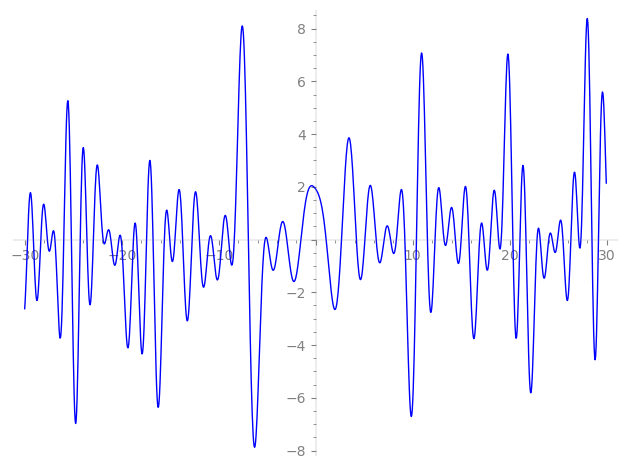| L(s) = 1 | + (0.366 − 1.36i)2-s + (0.525 + 1.96i)3-s + (−1.73 − i)4-s + 2.87·6-s + (2.45 + 0.978i)7-s + (−2 + 1.99i)8-s + (−0.976 + 0.563i)9-s + (1.05 − 3.92i)12-s + (2.23 − 2.99i)14-s + (1.99 + 3.46i)16-s + (0.412 + 1.53i)18-s + (−0.627 + 5.33i)21-s + (8.61 + 2.30i)23-s + (−4.97 − 2.87i)24-s + (2.69 + 2.69i)27-s + (−3.27 − 4.15i)28-s + ⋯ |
| L(s) = 1 | + (0.258 − 0.965i)2-s + (0.303 + 1.13i)3-s + (−0.866 − 0.5i)4-s + 1.17·6-s + (0.929 + 0.369i)7-s + (−0.707 + 0.707i)8-s + (−0.325 + 0.187i)9-s + (0.303 − 1.13i)12-s + (0.597 − 0.801i)14-s + (0.499 + 0.866i)16-s + (0.0972 + 0.362i)18-s + (−0.136 + 1.16i)21-s + (1.79 + 0.481i)23-s + (−1.01 − 0.586i)24-s + (0.517 + 0.517i)27-s + (−0.619 − 0.784i)28-s + ⋯ |
\[\begin{aligned}\Lambda(s)=\mathstrut & 700 ^{s/2} \, \Gamma_{\C}(s) \, L(s)\cr =\mathstrut & (0.993 - 0.111i)\, \overline{\Lambda}(2-s) \end{aligned}\]
\[\begin{aligned}\Lambda(s)=\mathstrut & 700 ^{s/2} \, \Gamma_{\C}(s+1/2) \, L(s)\cr =\mathstrut & (0.993 - 0.111i)\, \overline{\Lambda}(1-s) \end{aligned}\]
Particular Values
| \(L(1)\) |
\(\approx\) |
\(1.91202 + 0.106683i\) |
| \(L(\frac12)\) |
\(\approx\) |
\(1.91202 + 0.106683i\) |
| \(L(\frac{3}{2})\) |
|
not available |
| \(L(1)\) |
|
not available |
\(L(s) = \displaystyle \prod_{p} F_p(p^{-s})^{-1} \)
| $p$ | $F_p(T)$ |
|---|
| bad | 2 | \( 1 + (-0.366 + 1.36i)T \) |
| 5 | \( 1 \) |
| 7 | \( 1 + (-2.45 - 0.978i)T \) |
| good | 3 | \( 1 + (-0.525 - 1.96i)T + (-2.59 + 1.5i)T^{2} \) |
| 11 | \( 1 + (5.5 + 9.52i)T^{2} \) |
| 13 | \( 1 + 13iT^{2} \) |
| 17 | \( 1 + (-14.7 + 8.5i)T^{2} \) |
| 19 | \( 1 + (-9.5 + 16.4i)T^{2} \) |
| 23 | \( 1 + (-8.61 - 2.30i)T + (19.9 + 11.5i)T^{2} \) |
| 29 | \( 1 - 10.7iT - 29T^{2} \) |
| 31 | \( 1 + (15.5 + 26.8i)T^{2} \) |
| 37 | \( 1 + (32.0 + 18.5i)T^{2} \) |
| 41 | \( 1 + 9.87T + 41T^{2} \) |
| 43 | \( 1 + (-2.56 + 2.56i)T - 43iT^{2} \) |
| 47 | \( 1 + (-2.56 + 9.56i)T + (-40.7 - 23.5i)T^{2} \) |
| 53 | \( 1 + (45.8 - 26.5i)T^{2} \) |
| 59 | \( 1 + (-29.5 - 51.0i)T^{2} \) |
| 61 | \( 1 + (7.80 + 13.5i)T + (-30.5 + 52.8i)T^{2} \) |
| 67 | \( 1 + (-11.1 + 2.99i)T + (58.0 - 33.5i)T^{2} \) |
| 71 | \( 1 - 71T^{2} \) |
| 73 | \( 1 + (63.2 - 36.5i)T^{2} \) |
| 79 | \( 1 + (-39.5 + 68.4i)T^{2} \) |
| 83 | \( 1 + (11.3 - 11.3i)T - 83iT^{2} \) |
| 89 | \( 1 + (-16.0 + 9.24i)T + (44.5 - 77.0i)T^{2} \) |
| 97 | \( 1 - 97iT^{2} \) |
| show more | |
| show less | |
\(L(s) = \displaystyle\prod_p \ \prod_{j=1}^{2} (1 - \alpha_{j,p}\, p^{-s})^{-1}\)
Imaginary part of the first few zeros on the critical line
−10.70838355819460242764334104883, −9.661738922716089475254456429982, −8.981160088905628110273420069486, −8.392850963491811035805429343121, −6.94388042852336657505170871125, −5.21931869793364032573804257068, −5.00829314286767242305005458097, −3.81594203878196804645735002164, −2.98223103798158503775370978490, −1.52894681618869438209155325472,
1.07387959994689571930248599899, 2.65774135140634924413377543053, 4.19179926944345570524004576559, 5.06611891363606150915921860008, 6.22905770929840746329325269510, 7.04342338429909228479543116658, 7.71409346118178223890851401159, 8.312059725070778155924623881364, 9.187868143536258631895056561823, 10.38366371152418014009148218858

